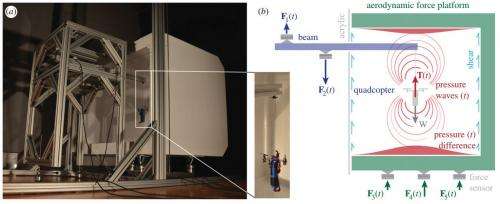January 14, 2015 weblog
Weight riddle solved by Stanford bird wing test

A new instrument may help to carry out tests to optimize miniature drones, in attempts to assess their flight performance more precisely. A team from Stanford University have shown how flapping wings enable flying animals and biomimetic robots to generate elevated aerodynamic forces. Animals with flapping wings range from insects and bats to birds and the latter have complex wing motions, such that the ways in which they are able to generate aerodynamic force are not fully understood. The team has made headway, via the measurement method they used. Thus far, measurements demonstrating this capability have been based on experiments with tethered robots and animals; indirect force calculations have been based on measured kinematics or airflow during free flight. "Remarkably," they said, "there exists no method to measure these forces directly during free flight." Now Prof. David Lentink's research team have developed a sensitive device that can measure the weight of a bird in flight; the force produced by every wing flap can be measured.
Apart from developing an instrument for drones, the Stanford team's investigation helps solve a riddle, said BBC News on Wednesday, a riddle about flying birds' weight. Does a container or truck carrying birds change in weight when the birds inside are flying? Or, to say it in the Telegraph's use of English: "Would a lorry carrying pigeons change weight if they all decided to fly?" One conclusion was reached in an episode of a US television show, said BBC News. A trailer was weighed while birds flew inside it. The answer was that it made no difference to when the birds were still. The Stanford team's device produced a different answer; "the weight of the container would actually change as the birds flapped their wings," said the BBC. Lentink, quoted in the Telegraph, said "you need an unpractical number of bird to cancel the fluctuations out." Looking from wingbeat to wingbeat, he said, one sees a lot of fluctuation."The weight of a truck containing just a few flying birds will fluctuate in time; only the lift of an incoherent flock of birds could cancel out [this change]," he said in BBC News. Hovering created double the lift during the wings' downstroke; the birds had no need to lift their weight in the upstroke.
The device is described in Journal of the Royal Society Interface. "In vivo recording of aerodynamic force with an aerodynamic force platform: from drones to birds" is by David Lentink, Andreas Haselsteiner and Rivers Ingersoll, from the department of mechanical engineering at Stanford. How they tested: they recorded the tiny forces from a single bird flying inside a specially designed chamber. They trained two Pacific parrotlets to fly from one perch to another and they examined the aerodynamic forces.
Looking ahead, the researchers said their work could help fine-tune miniature drones. "Here, we demonstrate a new aerodynamic force platform (AFP) for non-intrusive aerodynamic force measurement in freely flying animals and robots." The authors explained the AFP as a box, instrumented with load cells, that encloses the object or animal that generates the net unsteady fluid force. They said, "It works based on Newton's third law applied to a fluid; the unsteady net fluid force needs to be supported by an equal and opposite net force that acts on the control volume boundary."
More information: : Lentink D, Haselsteiner AF, Ingersoll R. In vivo recording of aerodynamic force with an aerodynamic force platform: from drones to birds, Journal of the Royal Society Interface, rsif.royalsocietypublishing.or … tent/12/104/20141283
Journal information: Journal of the Royal Society Interface
© 2015 Tech Xplore





















